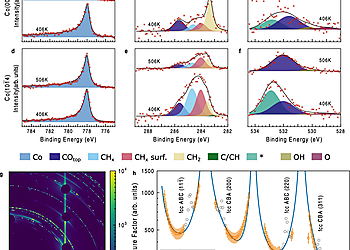In-situ probing of the Fischer-Tropsch reaction on Co single crystal surfaces up to 1 bar
Result of the Month
Surface state of Co(0001) sample at indicated temperatures in an atmosphere of CO:H2 1:2 at 1 bar studied by hard X-ray photoelectron spectroscopy (HAXPES) utilizing 4600 eV photons at 0.3° incidence. a shows Co 2p3/2 core-level spectra b displays the C 1 s region and c depicts the O 1 s region. Subplots d, e, f show the same conditions as a, b, c but for a Co(101¯4) surface. The columns of XPS data have constant scaling of the vertical axis. Subplot g shows a representative figure of the high energy surface X-ray diffraction HESXRD data at 67.4 keV of the Co(0001) crystal (full set is shown in SI). The detector is protected by beam stops at the bulk Bragg peak positions. h X-ray structure factor extracted from the 2D diffraction data shown in g at reaction conditions at 496 K and 1 bar reaction mixture (1:2 CO:H2), data from the hcp part of the surface used for the fit (orange circles with vertical lines indicating an estimation 10% relative error), data from the fcc part (grey circles), fit result (solid line).

